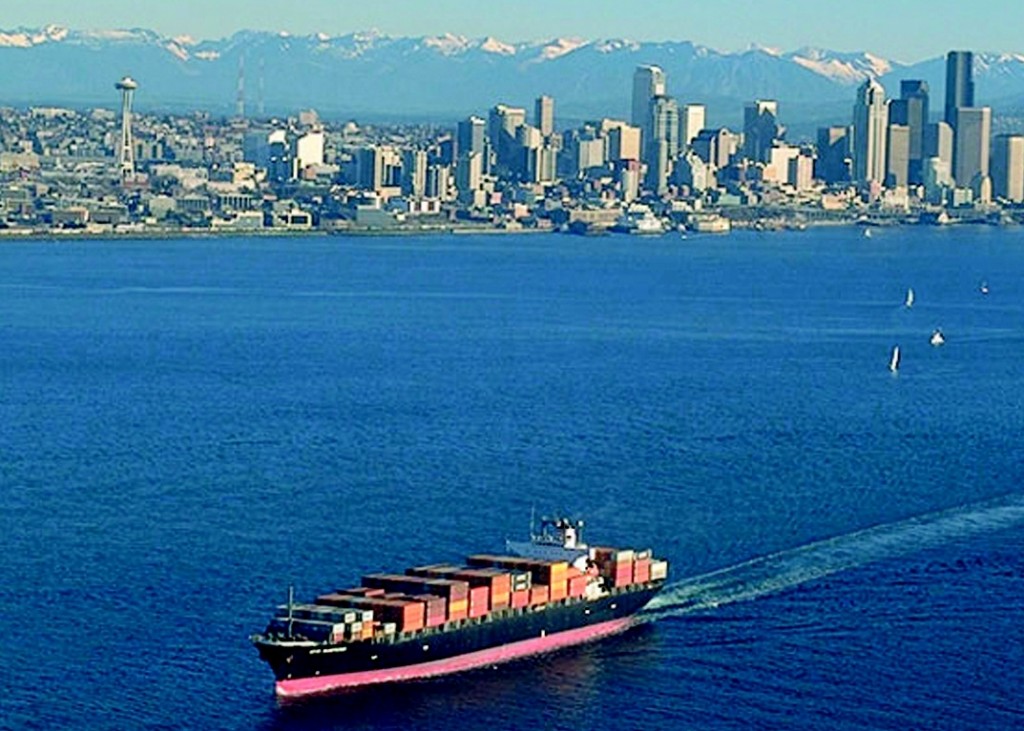This is a good story of how any delay in the opening of the to be widened Panama Canal will give some of the ports time to be ready with their needed expansion.
Staff writer January 19, 2014
The Panama Canal’s expansion to accommodate larger ships has been a brick-loaded safe suspended by a fraying thread over Puget Sound regional ports, threatening to flatten whatever growth prospects Tacoma or Seattle might believe they have.
It’s also been a handy cudgel for reinforcing arguments about what to do with or for the local ports once the widening project is complete. Depending on what side you’re on, the canal’s ability to accommodate larger ships is an argument for more investment in the ports of Tacoma and Seattle to keep them competitive with East Coast ports, or else an argument to give up and stop pouring money into them, since ships won’t be calling here when they can sail directly to Atlantic and Gulf destinations.
Those arguments spill over into other regional issues. For example: Want to keep the two big container ports competitive? Then we need to extend state Routes 167 and 509 to Interstate 5 so the ports can move truck traffic in and out more efficiently. Want to keep freight trains hauling containers to the rest of the country moving? Then why would you want to further clog already congested rail lines with trains hauling coal and oil to export terminals?
The Panama Canal threat has some deficiencies. Advocates of the regional ports say the West Coast still is the best entry point to deliver freight to the Upper Midwest and the best exit point to ship many goods to Asia, so the threat is overblown. They also note the amount of investment, including dredging projects, that will be required at some of the ports hoping to land those larger ships. Critics of the ports maintain there’s a threat all right, but it comes from the north, not the south, in the form of British columbia’s Vancouver or Prince Rupert, with lower costs and better rail connections. Others cite competition from West Coast ports including Los Angeles/Long Beach and Oakland, Calif., and maybe from Mexico as well.
Into these competing outlooks and scenarios comes a new wrinkle in the Panama Canal saga, and for this we need to refer to a sentence fragment in the second paragraph of this column, the one referring to “once the widening project is complete.”
Right now there’s some question when that will be — or if it will be.
News from Panama and Europe indicates a major fight has broken out between the canal authority and those working on the expansion. The Spanish consortium Grupo Unidos por el Canal, which is building a new set of locks, wants an additional $1.6 billion to cover cost overruns. The project is already behind schedule; a canal authority press release says the expansion project overall is 72 percent complete but the locks are just 65 percent done, and the locks project will be done in June 2015, not this coming October as originally called for.
Gee, a major infrastructure project running over budget and behind schedule. Imagine that ever happening in this country — or this state.
It is too much to hope, at least for those who see the newly expanded canal as a real threat to local port operations, that this dispute will cause indefinite postponement (the contractor group has threatened to stop work). The project is too far along and there’s too much at stake for both sides for either to quit. Bickering, even public sniping at one another, is hardly unusual in projects of this size and complexity. This will get resolved. For a huge project to get scrubbed completely, you have to have a near-cataclysmic confluence of cost overruns and revenue shortfalls — as was the case, now that you mention it, with the Washington Public Power Supply System (WPPSS) nuclear power plant debacle.
But the pause comes at an interesting time for the regional ports, given conjecture about long-term trends in trans-Pacific container traffic and whether it’s energy trading rather than boxes of stuff where the real action is (some Gulf Coast ports want to get a larger canal in place to handle Asia-bound LNG tankers; they’ll be in competition for that business with proposed LNG export terminals in Oregon and B.C.).
The ports of Tacoma and Seattle won’t get a reprieve from facing this new competitive threat, however much of one it turns out to be. But they may get a little extra time to strategize — as last week’s announcement of information sharing and discussions indicates they’re doing. They may feel compelled to throw some goodies the shipping lines’ way to keep them calling here (“hmm, if it worked for Boeing …”) or else to cut the expected losses now and find something less likely to be diverted through the canal to other ports – once, that is, there’s enough water there to literally float their boats.
Bill Virgin is editor and publisher of Washington Manufacturing Alert and Pacific Northwest Rail News.
Read more here: http://www.thenewstribune.com/2014/01/19/3001390/panama-canal-delays-give-local.html#storylink=cpy
